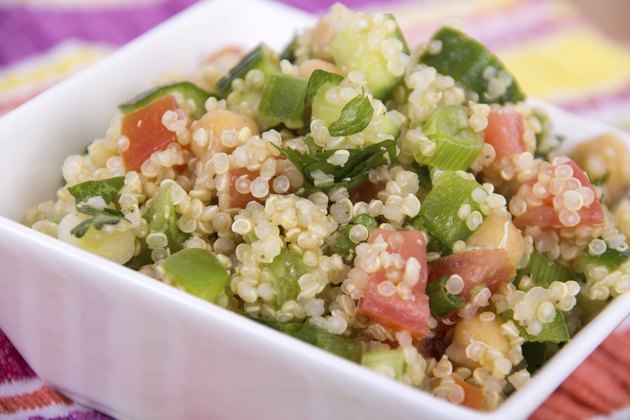Millet and quinoa are whole grains, meaning that they contain the entire grain kernel -- the bran, endosperm and germ. Technically, quinoa, which is related to beets, spinach and chard, classifies as a pseudo-grain because it's used like a grain and has a similar nutritional profile. Whole grains have health benefits over refined grains, which contain fewer nutrients as well as less fiber. Millet and quinoa differ in several ways.

Sponsored Links
Uses
Millet is more often used as bird seed than as food for people in the United States. In India, China, South America, Russia and the Himalayas, however, millet is a common grain staple. Most quinoa consumed in the United States comes from the Andes, where it's a staple food for many people. Millet comes in several forms, including pearl, proso, fingertail and finger millet. Different cultures use millet, the world's sixth most important grain, according to the Whole Grain Council, to make bread, porridge and beer. Quinoa, which comes in more than 120 varieties, is eaten as a side dish or used in cereals, crackers and granola.
Sponsored Links
Appearance Before Cooking
Most quinoa is white or ivory in color, but the grain also grows in red, black and purple varieties. Millet also grows in several colors; it can be white, red, yellow or gray. Pearl millet, the variety sold for human consumption in the United States, is a small, round, white or ivory-colored grain. Quinoa is also small but oval or disk-shaped disk shaped with a flattened or depressed band around the edges. Red, black and white quinoa are commercially available in the United States. Quinoa is covered with a black coating called saponine; you must wash that off before eating the grain because it has a soapy, bitter taste and is toxic, according to Vegetarians in Paradise. Quinoa sold commercially in the United States has the saponine already removed. Millet has a tiny dot on one side where it attaches during growing. It has a hull you must remove before eating.
Cooked Appearance
As quinoa cooks, the germ of the kernel forms a little spiral that lets you know when it's done. Millet has a slightly nutty flavor after cooking while quinoa has a light, chewy texture. Both millet and quinoa benefit from toasting lightly in a dry saucepan before cooking. Because they're both small grains, they cook quickly.
Nutrition
Quinoa contains all the essential amino acids, making it a complete protein, which is a rarity among grains. Quinoa contains more protein overall than most grains, with a protein percentage ranging from 7 percent to 22 percent, according to the website for Vegetarians in Paradise. Most grains, including millet, lack the essential amino acid lysine and have a lower overall protein content. Both quinoa and millet are gluten-free, making them ideal for people who have celiac disease or gluten intolerance.
REFERENCES & RESOURCES Whole Grains Council: Whole Grains from A to Z AAOOB.com: Grain Information Nutrition Action Health Letter: The Whole Grain Guide Vegetarians in Paradise: Quinoa Whole Gains Council: Millet and Teff Whole Grains Council: Quinoa Vegan Coach: How to Cook Millet